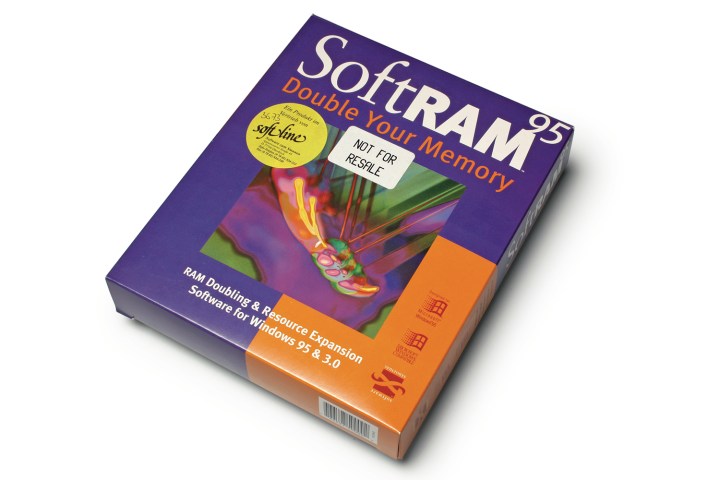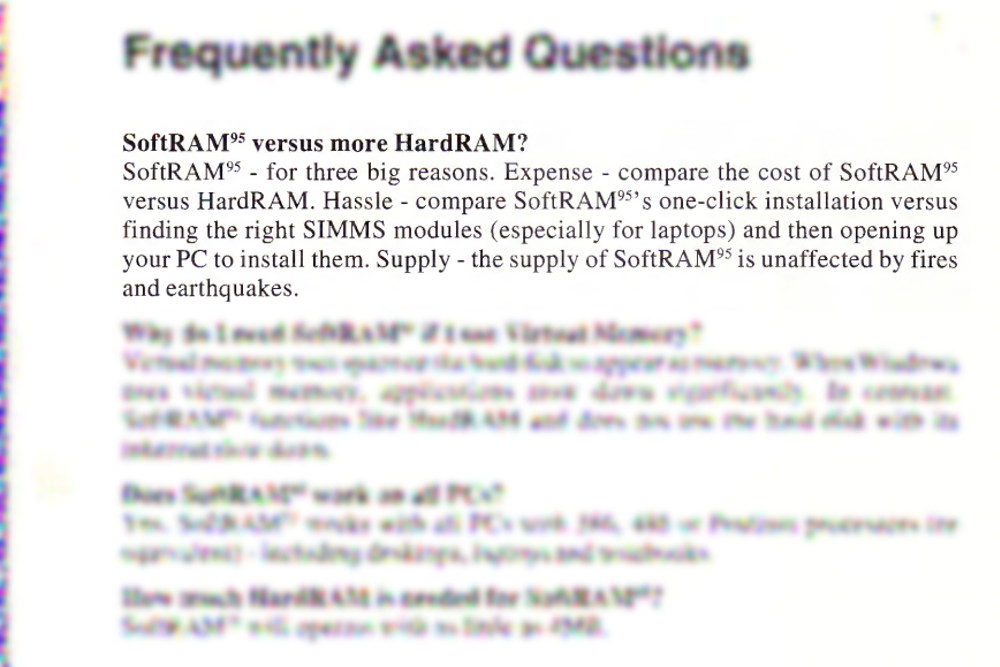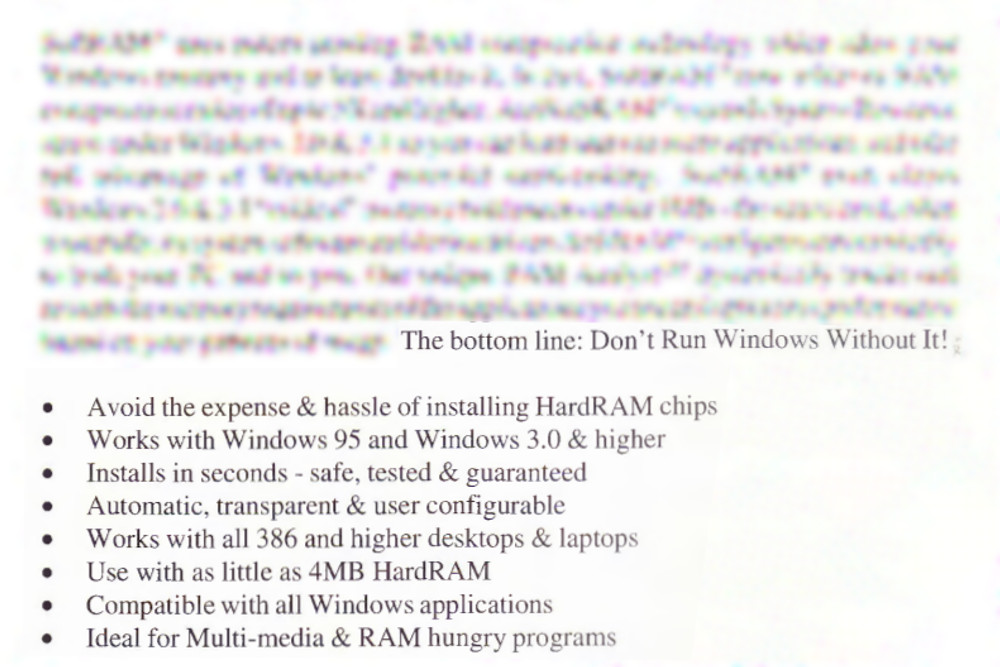
There was only one problem. SoftRAM 95 didn’t work.
Unfortunately, this wasn’t common knowledge. No one knew until after the software had become a best-seller across the globe. Back in the 1990s, SoftRAM hoodwinked hundreds of thousands of people. But that was before the age of widespread internet connectivity. Today, we’re more informed and harder to fool — right?
Captive Audience
“The reason that it got as much attention and publicity as it got was that on the day that Windows 95 launched — August 24, 1995 — it was the only Windows 95-specific software available,” recalled Larry Seltzer, then a technical director for PC Magazine.
“Someone told me that they had been testing this, and that their claims are full of crap,” Seltzer continued. “I had already been involved in test labs for a long time, and the people involved with those labs talked with each other, so there was a lot of behind-the-scenes chatter about it.”
Despite these rumors of wrong-doing, SoftRAM was a hit with the general public. The Windows 3.1 version of the software launched in May 1995, with the Windows 95 version following just three months later. Over 600,000 units had been sold by the end of the year.
This mainstream popularity, coupled with rumblings of foul play, prompted the PC Magazine staff to take a closer look at what SoftRAM was actually doing.

“There were two parts to SoftRAM,” explained Seltzer. “One of them was the device driver, the kernel mode software, which supposedly did the memory management and the compression. And then there’s this program that you run to see how much memory it’s compressing, and it shows dials and stuff.”
“It turns out that even if you don’t load the device driver at all, the program that shows you how much memory it’s compressing does exactly the same thing,” Seltzer laughed. He describes the interface as a “fabrication” — but it was enough to coerce thousands into parting with the software’s asking price of $79.95.
As 1996 got underway, mainstream reports of the product’s lack of substance started to gain traction. Seltzer was quoted as describing SoftRAM as “devoid of value” in an article published by CNN.
However, the scam could have been nipped in the bud months earlier. Suspicions had been raised early in 1995, but they fell on deaf ears.
Expert Opinion
Before Windows 95 was released, and before SoftRAM became a bestseller, Michael Spilo was alerted to the existence of the utility when the manager of a hedge fund requested his services as a consultant.
I tried to get some of the press to take a look at it, and they just ignored me.
“They were trying to find whether there was any substance to the product itself,” said Spilo, speaking with Digital Trends over the phone. “They had found me as a local expert in memory technologies, not knowing that I had a patent on RAM compression.”
Spilo was asked for his opinion on SoftRAM, and dutifully set about reverse-engineering the technology to see what was going on under the hood. What he found was damning.
“I found that there was no ‘there’ there, and that if there had been any ‘there’ there, they would be violating my patent,” Spilo explained. “I had no real claim against them, because it did nothing at all.”
He was able to find the “skeleton” of some compression code, but it was being intentionally bypassed. It wasn’t just that SoftRAM didn’t do its job. It didn’t even show up at the office.
Trouble Helix
The reason that Spilo knew so much about memory technology was simple. He was something of a pioneer in the field.
He founded the Helix Software Company in 1986, which was responsible for popular products like HeadRoom, Hurricane, and the Helix Multimedia Stacker. An article in InfoWorld magazine published in 1989 describes HeadRoom as “a software utility that allows users to switch between applications while requiring no memory overhead to store active applications.”
“There was a whole industry of trying to expand and get around the barriers that were built into the hardware, before the transition from a 16-bit environment to the 32-bit environment of Windows 95,” explained Spilo. “An industry had arisen to provide software that helped continue operating in a 16-bit environment.” He himself had several patents relating to memory management and virtual memory.
This knowledge allowed Spilo to see through SoftRAM’s facade, but his expert status would soon prove to be a major obstacle. He knew that he needed to spread the word about this scam product, and that he needed to go to the press to do so. However, response to his findings was colored by the fact that he was fielding similar software.
“People were pushing us and feeding us information because they had expertise,” said Larry Seltzer, remembering a tip he received from Spilo while writing for PC Magazine.
“I tried to get some of the press to take a look at it, and they just ignored me because I was a potential competitor,” Spilo explained. However, this was in the earlier part of 1995, before SoftRAM had become a bestseller. “It wasn’t on my radar as a competitor at all,” added Spilo. “It wasn’t one of the top memory management products, at this point.”

With the benefit of hindsight, we can see how Spilo’s claims might have been interpreted as the developer of an established memory management utility attempting to stifle competition.
However, he knew that SoftRAM couldn’t compete with what he was offering, because he knew that it didn’t work as advertised. As a result, he was more concerned with the fact that its developer, Syncronys, could potentially poison the well by damaging consumer trust in this kind of product.
“It had the potential to tar legitimate companies,” said Seltzer. And, indeed, when the Federal Trade Commission began to target Syncronys and SoftRAM in mid 1996, Spilo and Helix were hit hard. “Any software that made a similar claim was suspicious,” he said. The software that his company was offering was legitimate, but nevertheless he was forced to pour resources into defending that legitimacy.
Placebo Software
“I passed my findings on to anyone that would listen,” explained Spilo. “But basically, nothing happened until the German magazines did their own independent analysis and came to the same conclusion.”
A German magazine with a focus on the technical side of computing, called C’t, was responsible for one of the biggest blows to SoftRAM and Syncronys. Digital Trends asked Ingo Storm, one of thes author of the publication’s report on the software, whether it was difficult to prove that it didn’t live up to its billing.

“No,” he replied with a laugh. “It was absolutely ridiculously easy.” Unfortunately, getting word out to the public was substantially more difficult.
The initial C’t test on SoftRAM labelled the utility as “placebo software,” which raised the ire of its European distributor, SoftLine. The company sued C’t, claiming that its investigation used circumstantial evidence, and won.
The first virus scanner for iOS, for example, came from Avira. It did nothing.
SoftRAM was seemingly set to wriggle free of a complete expose once again, but C’t wasn’t prepared to give up without a fight. Storm’s greatest advantage was the full support of his editor-in-chief, a veteran of one of Germany’s daily newspapers who “never could be intimidated by anybody.”
“He asked me three times, ‘are you sure?’ and I said, ‘yes.'” said Storm. “He said, ‘OK, then go to press.'” The resulting report doubled down on the earlier article’s claims, proudly referring to it as “placebo forte!” in its headline. “We weren’t sued for that one,” added Storm.
Neither Syncronys or SoftLine could swat away the bad press that was brewing around SoftRAM. Given the amount of money consumers had already spent on the product, the story grew and grew — C’t published its in-depth report in late 1995, which is apparently when the FTC began its investigation. In July 1998, Syncronys declared bankruptcy.
Soft Sell
It’s easy to look back on SoftRAM as a product of the computing boom that took place in the 1990s. People were just starting to become accustomed to the idea of introducing a PC into their home, and ignorance certainly played into Syncronys’ success.
But are consumers really better informed today?
SoftRAM had the benefit of being released at a time when information traveled relatively slowly. Even computer-centric publications like PC Magazine and C’t published their findings in print ahead of debuting the content online, which meant that the information on offer was at least a few weeks old, and wasn’t freely available.
It’s unlikely that a modern example of “placebo software” could reach the same level of notoriety as SoftRAM without being thoroughly debunked online. However, the technique didn’t die with SoftRAM.

“It has been done,” said Ingo Storm, “The first virus scanner for iOS, for example, came from Avira. It did nothing, because it can’t do anything, under iOS. They gave it away for free, to collect addresses so that they could advertise their other software to people. Millions fell for it.”
This illustrates the lesson that authors of “placebo software” have taken from the SoftRAM situation — money draws attention. Charging hundreds of thousands of consumers $79.95 for a product that does nothing is going to attract the FTC, sooner or later. Instead, many modern scams are distributed for free. Money is made through advertising, or by selling user information.
SoftRAM was a ruse intended to force consumers to part with a decent chunk of change. Now, the same techniques are being used to harvest one of the digital era’s more desirable currencies: the personal information of ordinary individuals.
Whether it’s a phony memory booster, a phony virus checker, or a phony version of the latest game to top the app store charts, these placebo products all share one common trait. If there’s no real function to the software, there must be an ulterior motive in play.


